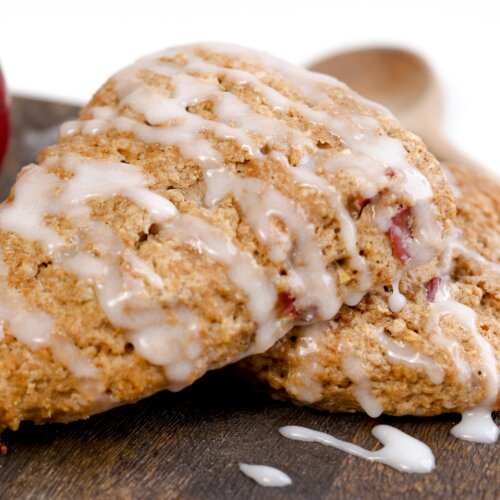
Sourdough Apple Cinnamon Scones with Glaze Recipe
These sourdough apple cinnamon scones are tender, flaky, and filled with fresh apples—finished with a sweet glaze for the perfect cozy treat.
Equipment
- Large mixing bowl
- Measuring cups and spoons
- Whisk or Fork Pastry Cutter or Fork
- Wooden spoon or spatula
- Baking sheet
- Parchment paper
- Rolling Pin
- Scone cutter or knife
- Pastry brush
- Cooling rack
- Bench scraper
Ingredients
- Butter: 1/2 cup = 113.5g
- All-purpose flour: 2 3/4 cups = 350g
- Apples chopped 1 cup = 150g
- Brown sugar: 1/2 cup = 110g
- Baking powder: 2 1/2 tsp = 10g
- Cinnamon: 3 tsp = 8g
- Salt: 1/2 tsp = 3g
- Egg: 1 large egg
- Sourdough starter discard or active: 1/2 cup = roughly 120g
- Heavy cream: 1/4 cup = 60g
- Vanilla extract: 1 1/2 tsp = 7.5g
- Glaze:
- Powdered sugar: 1 cup = 120g
- Cinnamon: 1/2 tsp = 1g
- Milk: 1-2 Tbsp = 15-45g depending on the consistency you want for the glaze
- Apple juice = 1-2 tbs adjust depending on the desired consistency
Notes
Tips
- Keep ingredients cold: Cold butter, egg, and even sourdough starter help create a flaky texture. You can chill the mixing bowl and utensils too.
- Aim for pea-sized butter pieces: When cutting in the butter, look for coarse crumbs with small, visible bits of butter—this is what gives you those tender layers.
- Mix gently: Overmixing will make the scones dense. Combine ingredients just until the dough comes together, even if it looks a bit rough.
- Chill before baking: That quick fridge time keeps the butter solid, which helps with rise and flakiness. In a warm kitchen, opt for the full 15 minutes.
- Cut evenly: Uniform wedges bake more evenly, so none are under- or overbaked.
- Space them out: Leave room between scones on the baking sheet for even air circulation.
- Check for doneness: Golden tops and a firm (but not hard) feel mean they’re ready. A toothpick should come out clean or with a few crumbs.
- Adjust glaze consistency: Too thick? Add milk. Too thin? Add powdered sugar. It should drizzle smoothly without soaking in completely.
- Cool before glazing: This helps the glaze set on top instead of melting into the scone.
Storage
Room Temperature (1–2 days): Cool completely, store in an airtight container away from heat and sunlight. Freezer (up to 3 months):- Best texture: freeze unglazed.
- Wrap each scone, then place in a freezer bag or airtight container.
- Thaw at room temperature or in the fridge, then reheat in a 300°F (150°C) oven for 10 minutes before glazing.